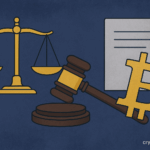The Norwegian Tax Administration (Skatteetaten) revealed that more than 73,000 taxpayers declared cryptocurrency holdings in their 2024 returns — up roughly 30 % from the 55,880 who declared in 2023. The total value of declared holdings exceeded US$4 billion, marking a significant rise in crypto-asset transparency in Norway.
Reporting highlights
- The number of individual taxpayers declaring crypto assets rose to 73,000 + in 2024.
- Total declared crypto holdings for 2024 surpassed US$4 billion.
- Among those declarations, the tax authority counted about US$550 million in gains and approximately US$290 million in losses from crypto holdings in 2024.
- The tax agency credited its efforts — including awareness campaigns and improved reporting systems — as contributing to the increase in filings. Skatteetaten Director Nina Schanke Funnemark stated, “We have taken severalJ measures in recent years to increase this number, and we see that these measures are having an effect.”
Why this matters
- Regulatory signal: The data suggests Norwegian authorities are gaining closer visibility into domestic crypto holdings — an important step in aligning crypto-asset activity with traditional tax regimes.
- Market transparency: A rise in declared assets helps reduce the tax gap, encourages compliance and provides the tax agency with better data on investor behaviour.
- Platform readiness for future reporting: The tax body noted that from 2026, crypto exchanges and custodians will be required to implement third-party reporting under the Crypto‑Asset Reporting Framework (CARF) standard.
- Investor clarity: For Norwegian crypto-holders, the emphasised3 guidance and transparency may reduce the risk of inadvertent non-compliance of tax obligations related to virtual assets.
Risks & considerations
- Residual undeclared holdings: Despite the increase, the number of crypto-holders who still do not declare assets remains significant — earlier research suggested a large proportion of holders did not report.
- Valuation and data accuracy: Crypto asset value is volatile and cross-border data from foreign exchanges may remain incomplete — posing challenges for both taxpayers and tax authorities.
- Compliance burden: As exchanges and custodians prepare for CARF-based reporting, smaller service-providers may face cost or operational burdens which could affect user access or service availability.
- Behavioural responses: With heightened scrutiny, some crypto-holders may shift activity to less visible platforms or offshore jurisdictions — complicating future tracking and taxation.
What to watch next
- 2026 exchange/custodian reporting: Implementation of third-party reporting rules (CARF) in January 2026 will be a key milestone; the tax authority’s disclosure of operational readiness will be important.
- Year-on-year trend continuation: Will the +30 % rise repeat in 2025 filings? A sustained trend would suggest long-term behavioural change among crypto investors.
- Audit and enforcement actions: Whether Skatteetaten initiates audits or enforcement proceedings using the new data will indicate how seriously it is leveraging improved reporting.
- Comparative international data: How Norway’s experience stacks up against other jurisdictions’ crypto-tax compliance rates will offer insight into global regulatory coordination.
Bottom line
Norway’s large increase in declared cryptocurrency holdings — both in terms of number of taxpayers and total value — underscores a growing trend of crypto-asset visibility in mainstream tax systems. The Skatteetaten’s efforts to boost compliance appear to be working, but challenges around valuation, comprehensive reporting and full transparency remain. As the digital-asset ecosystem continues to evolve, 2026’s expanded reporting regime may further accelerate accountability and data integration in the cryptocurrency space.
KLDKWIH8










